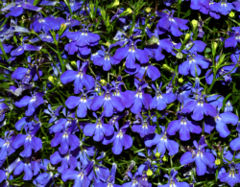Lobelia
| Lobelia subsp. var. | ||||||||||||||||||||||||||||||||||||||||||||||||||||||||
|---|---|---|---|---|---|---|---|---|---|---|---|---|---|---|---|---|---|---|---|---|---|---|---|---|---|---|---|---|---|---|---|---|---|---|---|---|---|---|---|---|---|---|---|---|---|---|---|---|---|---|---|---|---|---|---|---|

|
|
| ||||||||||||||||||||||||||||||||||||||||||||||||||||||
| ||||||||||||||||||||||||||||||||||||||||||||||||||||||||
| Standard Cyclopedia of Horticulture |
|---|
|
Lobelia (Matthias de Lobel, or L'Obel, 1538-1616, a Flemish botanist and author; Latinized Lobelius). Including Tupa. Campanulaceae. Excellent flower-garden and border plants, annual and perennial. Mostly herbs, some tropical species somewhat woody: lvs. alternate, sometimes the cauline ones reduced to bracts: fls. blue, red or yellowish, on 1-fld. pedicels, which are arranged in a terminal raceme; corolla gamo- petalous and tubular, split down one side; lobes 5, the 3 on the lower side (as the fl. stands) somewhat united and forming a lip, the other 2 (1 on either side of the cleft or split) erect or turned back; calyx short-tubular or globular, joined to the ovary, short-toothed; stamens 5, united into a tube around the single style, the tube often protruding from the cleft into the corolla: fr. a 2-valved caps.—-Species 250 or more, in many parts of the world, well represented in E. U. S. There are two horticultural groups of lobelias,—the annuals and the perennials. The annuals are low normally blue-flowered species suitable for bedding and edgings. They are of the easiest culture either from seeds or cuttings. See L. Erinus (No. 1). The perennials are again of two types,—the hardy and the half- hardy or tender. The hardy kinds are natives, of which L. cardinalis and L. syphilitica are the leading representatives. These inhabit bogs and low places, and the best results under cultivation are to be expected in moist and cool spots. The half-hardy sorts are chiefly derivatives of the Mexican L.fulgens, a plant deservedly popular in the Old World, but which has not attained great favor here. These species may be bedded out in the northern states. They are carried over winter in pots or in a cellar. They usually give good results the first year from seed, if started early; or seeds may be sown in the fall and the plants carried over in a frame. The hardiness of the hybrid perennial lobelias in this country is yet to be determined. It is probable that forms of L. fulgens will stand outdoors in the middle states if given winter protection. In the latitude of Washington they are hardy in winter but are scarcely able to withstand the summers.
|
- Do you have a description of this genus or plant? Edit this section!
Cultivation
- Do you have cultivation info on this plant? Edit this section!
Propagation
- Do you have propagation info on this plant? Edit this section!
Pests and diseases
- Do you have pest and disease info on this plant? Edit this section!
Species
Selected specieswp
Gallery
If you have a photo of this plant, please upload it! Plus, there may be other photos available for you to add.
-
photo 1
-
photo 2
-
photo 3
References
- Standard Cyclopedia of Horticulture, by L. H. Bailey, MacMillan Co., 1963
External links
- w:Lobelia. Some of the material on this page may be from Wikipedia, under the Creative Commons license.
- Lobelia QR Code (Size 50, 100, 200, 500)
